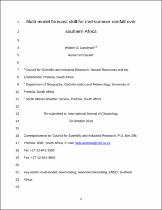JavaScript is disabled for your browser. Some features of this site may not work without it.
- ResearchSpace
- →
- Research Publications/Outputs
- →
- Journal Articles
- →
- View Item
| dc.contributor.author |
Landman, WA

|
|
| dc.contributor.author |
Beraki, Asmerom F

|
|
| dc.date.accessioned | 2012-03-29T12:45:58Z | |
| dc.date.available | 2012-03-29T12:45:58Z | |
| dc.date.issued | 2012-02 | |
| dc.identifier.citation | Landman, W.A. and Beraki, A.F. 2012. Multi-model forecast skill for mid-summer rainfall over southern Africa. International Journal of Climatology, vol. 32(2), pp 303-314 | en_US |
| dc.identifier.issn | 0899-8418 | |
| dc.identifier.uri | http://onlinelibrary.wiley.com/doi/10.1002/joc.2273/full | |
| dc.identifier.uri | http://hdl.handle.net/10204/5701 | |
| dc.description | Copyright: 2012 Wiley. This is the post-print version of the work. The definitive version is published in International Journal of Climatology, vol. 32, pp 303–314. doi: 10.1002/joc.2273 | en_US |
| dc.description.abstract | Southern African December-January-February (DJF) probabilistic rainfall forecast skill is assessed over a 22-year retroactive test period (1980/1981 to 2001/2002) by considering multi-model ensembles consisting of downscaled forecasts from three of the DEMETER models, the ECMWF, Meteo-France and UKMO coupled ocean-atmosphere general circulation models. These models are initialized in such a way that DJF forecasts are produced at an approximate 1-month lead time, i.e. forecasts made in early November. Multi-model forecasts are obtained by: i) downscaling each model’s 850 hPa geopotential height field forecast using canonical correlation analysis (CCA) and then simply averaging the rainfall forecasts; and ii) by combining the three models’ 850 hPa forecasts, and then downscaling them using CCA. Downscaling is performed onto the 0.5° × 0.5° resolution of the CRU rainfall data set south of 10° south over Africa. Forecast verification is performed using the relative operating characteristic (ROC) and the reliability diagram. The performance of the two multi-model combinations approaches are compared with the single-model downscaled forecasts and also with each other. It is shown that the multi-model forecasts outperform the single model forecasts, that the two multi-model schemes produce about equally skilful forecasts, and that the forecasts perform better during El Nino and La Nina seasons than during neutral years. | en_US |
| dc.language.iso | en | en_US |
| dc.publisher | Wiley | en_US |
| dc.relation.ispartofseries | Workflow;8590 | |
| dc.subject | Southern Africa rainfall forecast | en_US |
| dc.subject | Seasonal forecasting | en_US |
| dc.subject | Climatology | en_US |
| dc.subject | Probabilistic rainfall forecast skill | en_US |
| dc.subject | El Nino-Southern Oscillation | en_US |
| dc.subject | ENSO | en_US |
| dc.title | Multi-model forecast skill for mid-summer rainfall over southern Africa | en_US |
| dc.type | Article | en_US |
| dc.identifier.apacitation | Landman, W., & Beraki, A. F. (2012). Multi-model forecast skill for mid-summer rainfall over southern Africa. http://hdl.handle.net/10204/5701 | en_ZA |
| dc.identifier.chicagocitation | Landman, WA, and Asmerom F Beraki "Multi-model forecast skill for mid-summer rainfall over southern Africa." (2012) http://hdl.handle.net/10204/5701 | en_ZA |
| dc.identifier.vancouvercitation | Landman W, Beraki AF. Multi-model forecast skill for mid-summer rainfall over southern Africa. 2012; http://hdl.handle.net/10204/5701. | en_ZA |
| dc.identifier.ris | TY - Article AU - Landman, WA AU - Beraki, Asmerom F AB - Southern African December-January-February (DJF) probabilistic rainfall forecast skill is assessed over a 22-year retroactive test period (1980/1981 to 2001/2002) by considering multi-model ensembles consisting of downscaled forecasts from three of the DEMETER models, the ECMWF, Meteo-France and UKMO coupled ocean-atmosphere general circulation models. These models are initialized in such a way that DJF forecasts are produced at an approximate 1-month lead time, i.e. forecasts made in early November. Multi-model forecasts are obtained by: i) downscaling each model’s 850 hPa geopotential height field forecast using canonical correlation analysis (CCA) and then simply averaging the rainfall forecasts; and ii) by combining the three models’ 850 hPa forecasts, and then downscaling them using CCA. Downscaling is performed onto the 0.5° × 0.5° resolution of the CRU rainfall data set south of 10° south over Africa. Forecast verification is performed using the relative operating characteristic (ROC) and the reliability diagram. The performance of the two multi-model combinations approaches are compared with the single-model downscaled forecasts and also with each other. It is shown that the multi-model forecasts outperform the single model forecasts, that the two multi-model schemes produce about equally skilful forecasts, and that the forecasts perform better during El Nino and La Nina seasons than during neutral years. DA - 2012-02 DB - ResearchSpace DP - CSIR KW - Southern Africa rainfall forecast KW - Seasonal forecasting KW - Climatology KW - Probabilistic rainfall forecast skill KW - El Nino-Southern Oscillation KW - ENSO LK - https://researchspace.csir.co.za PY - 2012 SM - 0899-8418 T1 - Multi-model forecast skill for mid-summer rainfall over southern Africa TI - Multi-model forecast skill for mid-summer rainfall over southern Africa UR - http://hdl.handle.net/10204/5701 ER - | en_ZA |






